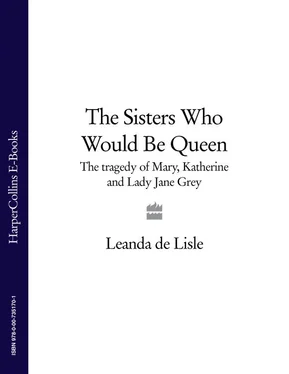Sudeley outlined to Dorset, as he had already to Northampton, a future in which Edward had come of age and rejected the unpopular Protector in favour of his younger uncle. There was a danger, Sudeley explained, that his brother would not give up power without a fight. It was necessary, therefore, to prepare for the struggle ahead. Northampton had been advised to ‘set up house in the North Country’ where, on his core estates, surrounded by tenants and friends, he would be a powerful figure. 20 Dorset was also now given detailed instructions on how to build up an effective military following. Gentlemen had too much to lose to be trustworthy, Sudeley told him. It was better to gain the loyalty of yeomen for they were ‘best able to persuade the multitude’. Dorset was advised to ‘go to their houses, now to one, now to another, carrying with you a flagon or two of wine and a pasty of venison and to use a familiarity with them, for so shall you cause them to love you’. 21 The talk of war seemed unreal to Dorset, but it was also fascinating. The aims were presented as altruistic: to protect the King from the overweening Somerset. But they coincided also with his personal interests. Dorset’s honour had been slighted by the Protector’s failure to recognise better his place within the royal family. As he returned to Bradgate he had to consider whether he should fight to protect it and whether the horrors of battle were justified by his duties to the King.
The Queen dowager’s confinement, meanwhile, was coming to an end and on 30th August 1548 she went into labour. Catherine had suffered a difficult and uncomfortable pregnancy, but she eventually delivered a healthy baby girl. Sudeley, despite his hopes for a son, was overwhelmed by the thrill of first-time fatherhood. His daughter was to be called Mary, after Edward’s elder half-sister, and he wrote to his brother, the father of many daughters, declaring his a most spectacular beauty. For a few days all seemed well and Jane Grey rejoiced with her surrogate family. Gradually, however, Catherine grew delirious: the fatal sign of puerperal fever. In her delirium she was tormented by her old fears about her husband’s desire to marry Elizabeth. ‘Those that be about me careth not for me,’ she confided to her servant Lady Elizabeth Tyrwhitt as Sudeley stood over her. ‘Why sweet heart, I would you no hurt,’ he reassured her. ‘No, my Lord, I think so,’ she replied, and whispered, ‘but my Lord you have given me many shrewd taunts.’ Sudeley lay down beside her on the bed and tried to comfort her. But she soon burst out with another accusation: she had not dared spend as much time with her doctor as she would like for fear of making him jealous.
Sudeley persisted in his efforts to reassure and soothe Catherine and, as it became clear she was dying, Jane and the other women read the Scriptures with her. They would have prayed also, as the chaplain arrived to perform the service for the Visitation of the Sick. The priest was expected to exhort Catherine to ask forgiveness for her sins and to forgive all those who had offended her, and before she died on 5th September, Catherine and Sudeley were reconciled. Her will left her husband everything she had, ‘wishing them to be a thousand times more in value than they were’. 22 For his part, Sudeley was left stunned by his wife’s death. The happiness at the birth of his daughter had tapped into a deep well of feeling and now he was plunged into desperate grief. ‘I was so amazed I had small regard either to myself or to my doings,’ he later recalled. Politics were forgotten. He went with his baby daughter to his brother the Protector’s house, to recuperate, and ordered that his own household be broken up. Jane Grey was to be sent back to Bradgate. But he asked first that she fulfil the role of chief mourner at Catherine’s funeral.
The eleven-year-old Jane performed her first public role with great dignity. She walked behind the Queen’s coffin in the procession from the house to the chapel at Sudeley, her small figure erect in a black gown, the long train ‘borne up by a young Lady’. She was, perhaps, the fifteen-year-old Elizabeth Tilney, the younger sister of the favourite lady-in-waiting of Henry’s fifth wife Katherine Howard, and a friend who would accompany Jane on the last procession of her life. 23 The funeral ceremony in the chapel was modest and took only a morning, but it was of disproportionate historical significance. This was the first Protestant royal funeral in English history. The biblical translator Miles Coverdale conducted the service in English and gave the sermon. In it he stressed that the alms given for the poor at the funeral and the candles burned were not to profit Catherine’s soul but to honour her memory. In reformed teaching there was no purgatory, where in Catholic belief sinners may, after death, do penance for their sins while the living pray for their release: the elect went straight to heaven, while the rest went to hell. Jane did not pray for Catherine, therefore, although she surely remembered her distraught guardian and his motherless baby.
When the service was over, and Catherine buried, Jane returned home. The records of the towns she travelled through on the road to Bradgate record the expenses laid out to entertain their royal visitor. When she was a little girl, Jane often saw her parents going off to Leicester and other local towns before returning with gifts from the mayor and the aldermen’s wives. There would be strawberries, walnuts, pears and home-made treats such as the spiced wine, ippocras. 24 Now she was treated with similar deference. Jane’s mother was not getting back the child she had said goodbye to a year before, but a questioning, maturing girl with a strong sense of her own dignity.
* John Foxe, who knew Aylmer, claimed that Jane was a better student than Edward, and Elizabeth’s later tutor, Roger Ascham, recorded her superiority to Elizabeth. Neither had reason to exaggerate.
* The Dorsets also later employed his wife, Alice, and a cousin at Bradgate.
Chapter V The Execution of Sudeley
Jane’s younger sisters had endured their share of mourning at Bradgate. Their mother Frances, who had been fond of Catherine Parr and kept her portrait all her life, had lost her younger sister, Eleanor, Countess of Cumberland, the previous November. Eleanor was still only in her twenties and left a husband stricken with shock, as well as an only daughter. 1 Then, on 3rd January 1548, when the family were celebrating the Christmas season at Bradgate, Dorset had received news that his younger sister, Anne Willoughby, was also dying. This branch of the Willoughbys, kin of Katherine Suffolk, were based in Nottinghamshire, not far from Bradgate, and the two families were very close.
Katherine and Mary understood something of Jane’s grief, then, as they prepared to welcome her home after the Queen dowager’s funeral. The excitement of having their sister with them again and the hopes of exchanging confidences, soon gave way, however, to the awkwardness of readjustment. The three-year gap between Jane and Katherine seemed suddenly very wide. While Katherine and Mary Grey were both still of an age when they wanted to please their parents, Jane was more questioning. At eleven she was showing the same rebellious streak her father had had at her age. Dorset used to infuriate his Latin teacher, Richard Croke, by laughing at rude jokes about the clergy, and then, when Croke complained, by stirring up the other pupils against him. 2 Jane felt equally irritated by the restrictions and demands imposed on her at Bradgate. She had got used to a long rein at Seymour Place and resented her mother’s efforts to reassert her authority. Frances, in turn, was angered and worried by Jane’s defiance.
In Tudor thinking, to rule and to obey were the essential characteristics of an ordered society. Frances believed that, with discipline, Jane’s youthful wilfulness could be transformed into willpower and become a force for good. Without it, however, she would pursue only her own selfish appetites. That, Frances feared, was dangerous for Jane and for society. As the heiress of a noble house, and perhaps even a future Queen, Jane could do great things for her country, or great harm. Frances was furious that Sudeley had not done a better job of guiding her child, and to her horror, less than a fortnight after Jane’s return home, Sudeley asked for her to be sent back to him.
Читать дальше












